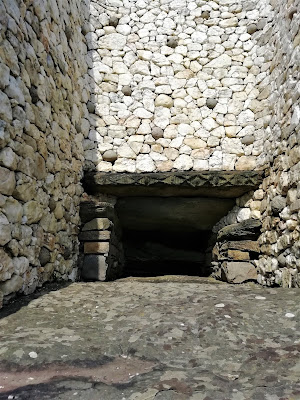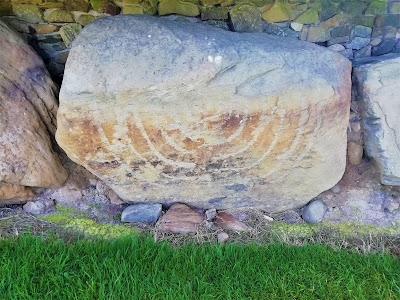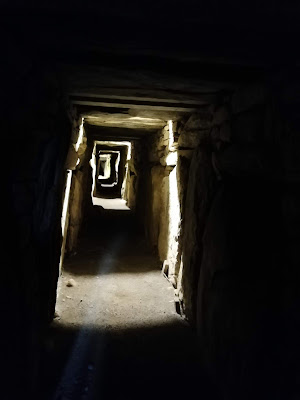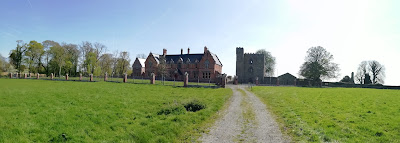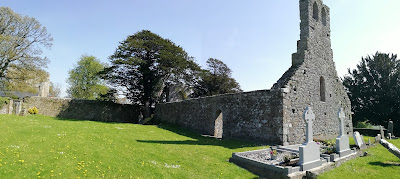Newgrange, Knowth, and Dowth, as of the present time are three individual sites which together make up the UNESCO World Heritage Site of Brú na Bóinne in Meath. As of 2018 a further significant Neolithic Passage Tomb with Rock Art Kerbstones has been unearthed on private land nearby.
Brú na Bóinne is a collection of Neolithic Passage Tombs roughly 5,500 years old.They are older than either the Pyramids of Egypt or Stonehenge. The Tombs probably took decades to build and the labour involved in just getting the various stones to Newgrange is testament to a complex and skilled earlier society.
It must be 30 years or more since last I visited Newgrange. There was no Interpretative Centre at that time and you simply made your own way to the various sites. Newgrange as of 2019 is a vastly different place from back then.
A Visitor/Interpretative Centre at Brú na Bóinne is where any visit begins. There is no direct access allowed to either Newgrange or Knowth but you can make your own way to Dowth if you are feeling a little adventurous.
When I visited Newgrange recently I was struck by the amount of reconstruction that had taken place. Previously there was no white Quartz visible on the monument.
There's a fine line between conservation or preservation and reconstruction. It's hard to make an unbiased comment but for my 2 cents worth that line has been crossed at Newgrange.
There's a fine line between conservation or preservation and reconstruction. It's hard to make an unbiased comment but for my 2 cents worth that line has been crossed at Newgrange.
The on site Visitor/Interpretative Centre was closed throughout early 2019 for refurbishment so the OPW were offering free tours which is to be applauded.
From the Visitor Centre you make your way across the footbridge which spans the River Boyne to the Shuttle Bus collection point, a short walk away. Tickets are available before you start for either Newgrange, Knowth, or both. Dowth is not included in the tours.
To be perfectly honest Newgrange, despite its beautiful and complex interior left me unimpressed. Perhaps my mind couldn't reconcile the reconstructed front facade of the Tumulus. It just seemed too new, the lines too clean, and so different from what I had previously seen decades before.
Knowth on the other hand was a different experience altogether. The sheer amount of Tombs gathered together in one small location at Knowth is staggering.
The stones which surround the Passage Tombs at Knowth (Kerbstones) are covered in various Rock Art designs and there are quite a lot of them. I was once told that Ireland contains over 60% of Europe's Neolithic Art and standing at Knowth I could well believe that figure.
The Tumuli at Knowth are covered in lush grassy mounds and have been extended slightly to provide overhead cover to help protect the Kerbstones.
The Tumuli at Knowth are covered in lush grassy mounds and have been extended slightly to provide overhead cover to help protect the Kerbstones.
There was no entrance to the Passages or Souterrains (later underground passages) at Knowth however the time allotted seemed to run out all too quickly because I was busy looking down the various passages and staring at the multitude of Artwork. Then it was back to the Shuttle Bus to return to the visitor centre.
Like many Neolithic sites Knowth has seen continuous use throughout prehistory and evidence of both later Bronze and Iron age use were found on site. I suppose if we look at it from the perspective of the distant future we are providing the evidence today of its use in the 21st Century as a place to visit !
I hadn't previously visited Knowth so I have no idea how it once looked. It seems that all Neolithic Passage Tombs when constructed were subsequently covered in thousands of smaller stones and rocks in a domed shape which sloped outwards to their Kerbstones.
Whether our Neolithic ancestors kept the domed roofs clear of grass and vegetation I don't know but I doubt it. At the rate vegetation grows they would have been constantly weeding through thousands of rocks so I presume the mounds covering the Passage Tombs close to Sea Level were green and grassy just as they are at Knowth.
It was presumed that at Newgrange the white Quartz stone was used for facing the front of the mound so that it reflected brightly in Sunlight and "made a statement" for quite a distance. This seems plausible however it is also quite possible that the white Quartz was a circular pathway on the ground below or perhaps it was originally on the roof "beaming back light to the Gods". Not being an Archaeologist I presume this thinking makes me a heretic.
Queues for entrance to Newgrange can be long but for some reason less people go to Knowth, probably because they don't realise how beautiful it is. You'll spend a few minutes in the Shuttle Bus and are allowed roughly an hour on either site. I wished I could have spent more time at Knowth.
The third location, Dowth, is not included in any tour at Brú na Bóinne. Entrance to Dowth is free of charge.
Between 1847/48 Dowth was "archaeologically" excavated. Basically in the search for it's buried passages parts were blown off it with explosives and much of it was dug up leaving today what looks like a large crater in the centre.
The passages although once open to the public can no longer be accessed but you can go to the entrances and have a look down them. Some of the Kerbstones remain buried but many are above the surface and a few of the stones have Rock Art carved on them. Dowth is well worth taking the time to visit if only to enjoy the peace and quiet.
Right beside Dowth is an old ruined Church with a memorial to John Boyle O'Reilly who was born in the area. A Fenian, Writer and Publisher, O'Reilly is quite an interesting character in his own right. Sentenced to death but transported to the Penal Colonies of Australia he led a very eventful life.
Navan History -John Boyle O'Reilly
Navan History -John Boyle O'Reilly
The Church has associations with the Netterville family who refused to convert from Catholicism and a Church has probably stood on this site from at least the 12th Century though this particular ruin dates from much later. Beside it stands Netterville Manor and a Tower House, Dowth Castle.
The journey from Newgrange to Dowth pass's the site of the Battle of the Boyne which is now run by the OPW and worth visiting if in the area. It has a small collection of memorabilia and some nice Garden Walks as well.
Dowth is close to Newgrange but NOT Newgrange Visitor Centre (Brú na Bóinne). Because the Visitor Centre is situated on the opposite side of the River Boyne if you're traveling to Dowth from the Visitor Centre you will have to head through Donore Village, then past Oldbridge and onto the N51. Go left and then after about a Kilometre it is signed to the left again. It's not difficult to find.
Loughcrew near Oldcastle in Meath also contains a large Neolithic complex of Passage Tombs. Those at Loughcrew are in a more "natural" state having had little work carried out on the site.
Visiting Loughcrew involves a short walk uphill on grassy slopes. There is an OPW presence on site at Loughcrew throughout the Summer.


